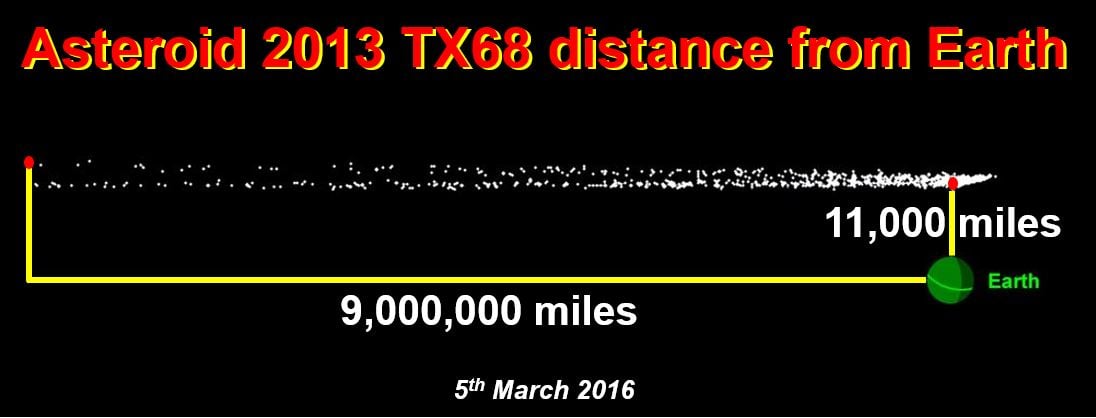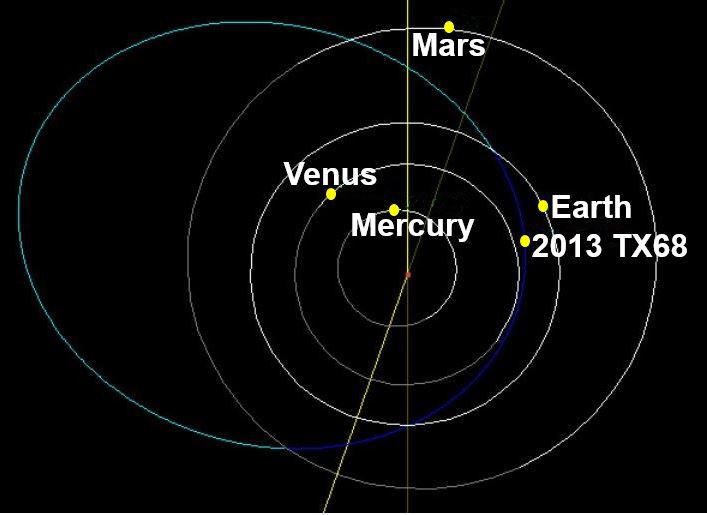A small asteroid will fly super close to Earth on 5th March, so near says NASA as to be considered an ultra-close near miss – astronomically speaking, that is. The asteroid, called 2013 TX68 could come as near as 11,000 miles (17,000 km). It may also whiz past at a distance of 9 million miles (14 million km) from Earth; scientists are not yet sure.
Two years ago, the celestial object missed us by a comfortable 1.3 million miles (2 million km).
The wide variation in the estimate for its closest approach is due to several possible trajectories it could take. It has only been tracked for a very short time.
 Asteroid 2013 TX68’s flyby could be ever so close. (Image adapted from: jpl.nasa.gov)
Asteroid 2013 TX68’s flyby could be ever so close. (Image adapted from: jpl.nasa.gov)
Could the asteroid hit Earth?
If our estimates vary by millions of miles, couldn’t we be wrong about the closest distance? In other words, is there a chance it will crash into our planet?
Scientists at NASA’s Center for NEO (Near Earth Object) Studies (CNEOS) at the Jet Propulsion Laboratory in Pasadena, California, say that according to their calculations there is no chance at all – during the flyby it will not hit Earth.
However, when it does another flyby on September 28th, 2017, there is a very remote chance it could collide with our planet. NASA scientists say the odds are 1 in 250 million. When it comes back again in 2046 and 2097 the risk is even more remote, they add.
Paul Chodas, manager of CNEOS, said:
“The possibilities of collision on any of the three future flyby dates are far too small to be of any real concern. I fully expect any future observations to reduce the probability even more.”
Bigger than the Chelyabinsk meteor
The asteroid is estimated to have a diameter of approximately 100 feet (30 metres). This may sound small, but the one that exploded in the atmosphere over Chelyabinsk in Russia on 15 February 2013 was just 65 feet (20 metres) across. Russian authorities reported that 1,491 people sought medical attention, 112 were hospitalized, and 7,200 buildings were damaged.
 NASA’s best approximation for the orbit of asteroid 2013 TX68. Nobody can be 100% sure how close it will pass us. Both the asteroid and Earth orbit the Sun counterclockwise.
NASA’s best approximation for the orbit of asteroid 2013 TX68. Nobody can be 100% sure how close it will pass us. Both the asteroid and Earth orbit the Sun counterclockwise.
As the Chelyabinsk meteor exploded in the air, the bulk of its energy was absorbed by the atmosphere. The explosion produced a total kinetic energy of about 500 kilotons of TNT, or twenty to thirty times more energy than the atomic bomb that detonated at Hiroshima, Japan, during the Second World War.
If asteroid 2013 TX68 struck Earth it would probably produce an air burst with about twice the energy of the one at Chelyabinsk. If it struck a major city like London, New York, Shanghai or Tokyo, the consequences could be devastating. Imagine forty to sixty Hiroshima atomic bombs exploding above London.
Asteroid 2013 TX68 was discovered by the Catalina Sky Survey on 6th October 2013 as it approached our planet on the night-time side. Following three days of tracking, it passed into the daytime sky and could no longer be observed.
As we have not been monitoring it for long, researchers are unable to predict its precise orbit around the Sun. However, NASA scientists insist there is no chance it will strike us on 5th March.
Dr. Chodas said:
“This asteroid’s orbit is quite uncertain, and it will be hard to predict where to look for it. There is a chance that the asteroid will be picked up by our asteroid search telescopes when it safely flies past us next month, providing us with data to more precisely define its orbit around the sun.”
Atomic bombs to target killer asteroids
The European Commission is funding a group of Russian scientists in a study to determine how nuclear bombs could be used to defend our planet from killer asteroid impacts.
The atomic bombs could be used to target asteroids and send them on a non-Earth-bound trajectory. The outer layers of the celestial object would evaporate in the explosion, and it would be pushed off course, thus missing the Earth.
The NEOShield project, a collaboration involving thirteen partners from across the world from research centres to industry, was granted FP7 funding by the European Commission two years ago to find ways of preventing NEO impacts using space-based deflection technologies.
NASA defines Near Earth Objects (NEOs) as comets or asteroids that have been pulled by the gravitation attraction of planets nearby into orbits that bring them into our backyard.
Video – Asteroid 2013 TX68 to pass near Earth

